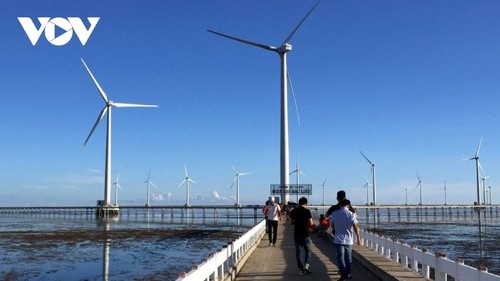 Wind power field in Bac Lieu Wind power field in Bac Lieu |
Vietnam has an offshore wind power potential of more than 1,000 GW, according to a recent report by the National Center for Hydro-Meteorological Forecasting (NCHMF), UNDP, and the Norwegian Embassy. The figure is far from previous assessments by the World Bank and the greatest wind power potential is in Bạc Lieu-Ca Mau and Ninh Thuan-Binh Thuan.
By providing an in-depth analysis of seasonal fluctuations, identifying the "golden" periods for offshore wind power generation, the report will be a practical guiding tool for Vietnam to develop its wind power sector and attract investment, especially when the National Power Development Plan until 2030, with a vision to 2050 has recently been approved.
Jacques Etienne Michel, country managing director of Norway's energy firm Equinor, has underscored the important role of offshore wind power in sustainable development in Vietnam. “Vietnam will not be able to make a successful energy transition without developing offshore wind power. Vietnam has a great coastline, great renewable energy resources, actually the best in South East Asia. There’s no way than we all need to work together to make this happen,” said Michel.
 Jacques Etienne Michel, country managing director of Norway's energy heavyweight Equinor (Photo credit: Equinor) Jacques Etienne Michel, country managing director of Norway's energy heavyweight Equinor (Photo credit: Equinor) |
Vietnam has been building a roadmap for offshore wind power development which requires a long-term process, thorough preparations in human resources, infrastructure, and especially a clear legal framework. The revised Electricity Law, passed at the end of last year, for example, includes mechanisms like Build-Operate-Transfer (BOT) contracts for offshore wind projects, offering new opportunities for domestic and international investors.
Du Van Toan, an expert in renewable energy at the Institute of Seas and Islands of the Ministry of Agriculture and Environment, said, “The revised Electricity Law includes a dedicated chapter on offshore wind power, with specific provisions aiming to reach a capacity of nearly 110GW by 2050, contributing about one-third of the total electricity supply for Vietnam's economic activities.”
Toan underscored the need to have specific legal frameworks to secure long-term investment capital and give investors confidence to commit over a 20–30-year horizon. Without a long-term vision, it's difficult for offshore wind projects to thrive. International cooperation has been enhanced in personnel training and exchange of knowledge in infrastructure and policies to support the development of offshore wind power industrial hubs.
Nguyen Van Thanh, former Director of Hai Phong's Department of Industry and Trade, said Hai Phong city is among the front-runners in this field. “Vietnamese enterprises are gradually reaching international standards through training and capacity-building programs,” said Thanh, adding, “We have outlined the national offshore wind power development planning with specific wind assessment criteria for businesses and survey units. These indicators offer promising prospects for the future growth of offshore wind energy at the local level.”
 Du Van Toan, an expert in renewable energy of the Ministry of Agriculture and Environment (Photo: quochoi.vn) Du Van Toan, an expert in renewable energy of the Ministry of Agriculture and Environment (Photo: quochoi.vn) |
Binh Dinh province is completing procedures for Germany’s PNE Group to soon begin its offshore wind power project at Hon Trau, with a planned capacity of 2,000 MW and an investment of 4.6 billion USD.
The project is divided into three phases, each with an investment of 1.5 billion USD, and is expected to begin operation by 2030. Once operational, it is projected to supply electricity to 3.5 million households in Binh Dinh and across Vietnam and help reduce 130 million tons of CO2 emissions over its 35-year lifespan.
According to Ho Quoc Dung, Secretary of the provincial Party Committee, “It is PNE Group’s first project in Vietnam. We pledge full support and continued cooperation with PNE to carry out the project and make it a success.”
With a detailed roadmap in place, Vietnam is shaping a marine wind power industry, contributing to its commitment to achieving Net Zero emissions by 2050 and enhancing its position in the global renewable energy landscape.